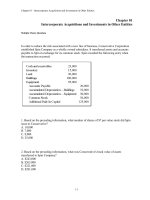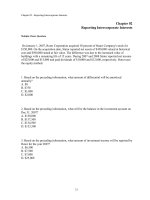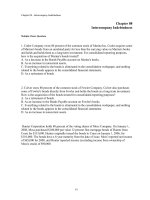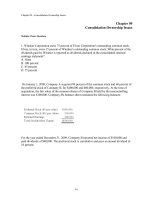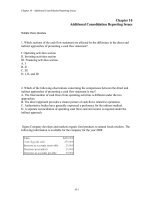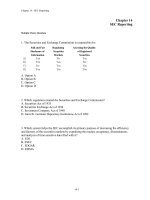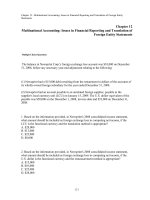Test bank advanced financial accounting ch 03 the reporting entity and consolidated financial
Bạn đang xem bản rút gọn của tài liệu. Xem và tải ngay bản đầy đủ của tài liệu tại đây (307.88 KB, 37 trang )
Chapter 03 - The Reporting Entity and Consolidated Financial Statements
Chapter 03
The Reporting Entity and Consolidated Financial Statements
Multiple Choice Questions
On January 3, 2009, Jane Company acquired 75 percent of Miller Company's outstanding
common stock for cash. The fair value of the noncontrolling interest was equal to a
proportionate share of the book value of Miller Company's net assets at the date of
acquisition. Selected balance sheet data at December 31, 2009, are as follows:
1. Based on the preceding information, what amount should be reported as noncontrolling
interest in net assets in Jane Company's December 31, 2009, consolidated balance sheet?
A. $90,000
B. $54,000
C. $36,000
D. $0
2. Based on the preceding information, what amount will Jane Company report as common
stock outstanding in its consolidated balance sheet at December 31, 2009?
A. $120,000
B. $180,000
C. $156,000
D. $264,000
3-1
Chapter 03 - The Reporting Entity and Consolidated Financial Statements
Beta Company acquired 100 percent of the voting common shares of Standard Video
Corporation, its bitter rival, by issuing bonds with a par value and fair value of $150,000.
Immediately prior to the acquisition, Beta reported total assets of $500,000, liabilities of
$280,000, and stockholders' equity of $220,000. At that date, Standard Video reported total
assets of $400,000, liabilities of $250,000, and stockholders' equity of $150,000. Included in
Standard's liabilities was an account payable to Beta in the amount of $20,000, which Beta
included in its accounts receivable.
3. Based on the preceding information, what amount of total assets did Beta report in its
balance sheet immediately after the acquisition?
A. $500,000
B. $650,000
C. $750,000
D. $900,000
4. Based on the preceding information, what amount of total assets was reported in the
consolidated balance sheet immediately after acquisition?
A. $650,000
B. $880,000
C. $920,000
D. $750,000
5. Based on the preceding information, what amount of total liabilities was reported in the
consolidated balance sheet immediately after acquisition?
A. $500,000
B. $530,000
C. $280,000
D. $660,000
3-2
Chapter 03 - The Reporting Entity and Consolidated Financial Statements
6. Based on the preceding information, what amount of stockholders' equity was reported in
the consolidated balance sheet immediately after acquisition?
A. $220,000
B. $150,000
C. $370,000
D. $350,000
7. Company Pea owns 90 percent of Company Essone which in turn owns 80 percent of
Company Esstwo. Company Esstwo owns 100 percent of Company Essthree. Consolidated
financial statements should be prepared to report the financial status and results of operations
for:
A. Pea.
B. Pea plus Essone.
C. Pea plus Essone plus Esstwo.
D. Pea plus Essone plus Esstwo plus Essthree.
8. Xing Corporation owns 80 percent of the voting common shares of Adams Corporation.
Noncontrolling interest was assigned $24,000 of income in the 2009 consolidated income
statement. What amount of net income did Adams Corporation report for the year?
A. $150,000
B. $96,000
C. $120,000
D. $30,000
9. On December 31, 2009, Rudd Company acquired 80 percent of the common stock of
Wilton Company. At the time, Rudd held land with a book value of $100,000 and a fair value
of $260,000; Wilton held land with a book value of $50,000 and fair value of $600,000. Using
the parent company theory, at what amount would land be reported in a consolidated balance
sheet prepared immediately after the combination?
A. $550,000
B. $590,000
C. $700,000
D. $860,000
3-3
Chapter 03 - The Reporting Entity and Consolidated Financial Statements
10. Princeton Company acquired 75 percent of the common stock of Sheffield Corporation on
December 31, 2009. On the date of acquisition, Princeton held land with a book value of
$150,000 and a fair value of $300,000; Sheffield held land with a book value of $100,000 and
fair value of $500,000. Using the entity theory, at what amount would land be reported in a
consolidated balance sheet prepared immediately after the combination?
A. $650,000
B. $500,000
C. $550,000
D. $375,000
11. If Push Company owned 51 percent of the outstanding common stock of Shove Company,
which reporting method would be appropriate?
A. Cost method
B. Consolidation
C. Equity method
D. Merger method
12. Under FASB 141R, consolidation follows largely which theory approach?
A. Proprietary
B. Parent company
C. Entity
D. Variable
3-4
Chapter 03 - The Reporting Entity and Consolidated Financial Statements
On January 3, 2009, Redding Company acquired 80 percent of Frazer Corporation's common
stock for $344,000 in cash. At the acquisition date, the book values and fair values of Frazer's
assets and liabilities were equal, and the fair value of the noncontrolling interest was equal to
20 percent of the total book value of Frazer. The stockholders' equity accounts of the two
companies at the acquisition date are:
Noncontrolling interest was assigned income of $11,000 in Redding's consolidated income
statement for 2009.
13. Based on the preceding information, what amount will be assigned to the noncontrolling
interest on January 3, 2009, in the consolidated balance sheet?
A. $86,000
B. $44,000
C. $68,800
D. $50,000
14. Based on the preceding information, what will be the total stockholders' equity in the
consolidated balance sheet as of January 3, 2009?
A. $1,580,000
B. $1,064,000
C. $1,150,000
D. $1,236,000
3-5
Chapter 03 - The Reporting Entity and Consolidated Financial Statements
15. Based on the preceding information, what will be the amount of net income reported by
Frazer Corporation in 2009?
A. $44,000
B. $55,000
C. $66,000
D. $36,000
16. Goodwill under the parent theory:
A. exceeds goodwill under the proprietary theory.
B. exceeds goodwill under the entity theory.
C. is less than goodwill under the entity theory.
D. is less than goodwill under the proprietary theory.
Small-Town Retail owns 70 percent of Supplier Corporation's common stock. For the current
financial year, Small-Town and Supplier reported sales of $450,000 and $300,000 and
expenses of $290,000 and $240,000, respectively.
17. Based on the preceding information, what is the amount of net income to be reported in
the consolidated income statement for the year under the parent company theory approach?
A. $220,000
B. $202,000
C. $160,000
D. $200,000
18. Based on the preceding information, what is the amount of net income to be reported in
the consolidated income statement for the year under the proprietary theory approach?
A. $210,000
B. $202,000
C. $160,000
D. $200,000
3-6
Chapter 03 - The Reporting Entity and Consolidated Financial Statements
19. Based on the preceding information, what is the amount of net income to be reported in
the consolidated income statement for the year under the entity theory approach?
A. $210,000
B. $202,000
C. $160,000
D. $220,000
20. Quid Corporation acquired 75 percent of Pro Company's common stock on December 31,
2006. Goodwill (attributable to Quid's acquisition of Pro shares) of $300,000 was reported in
the consolidated financial statements at December 31, 2006. Parent company approach was
used in determining this amount. What is the amount of goodwill to be reported under
proprietary theory approach?
A. $300,000
B. $400,000
C. $150,000
D. $100,000
21. Quid Corporation acquired 60 percent of Pro Company's common stock on December 31,
2004. Goodwill (attributable to Quid's acquisition of Pro shares) of $150,000 was reported in
the consolidated financial statements at December 31, 2004. Proprietary theory approach was
used in determining this amount. What is the amount of goodwill to be reported under entity
theory approach?
A. $150,000
B. $200,000
C. $250,000
D. $100,000
22. Blue Company owns 80 percent of the common stock of White Corporation. During the
year, Blue reported sales of $1,000,000, and White reported sales of $500,000, including sales
to Blue of $80,000. The amount of sales that should be reported in the consolidated income
statement for the year is:
A. $500,000.
B. $1,300,000.
C. $1,420,000.
D. $1,500,000.
3-7
Chapter 03 - The Reporting Entity and Consolidated Financial Statements
23. In which of the following cases would consolidation be inappropriate?
A. The subsidiary is in bankruptcy.
B. Subsidiary's operations are dissimilar from those of the parent.
C. The parent owns 90 percent of the subsidiary's common stock, but all of the subsidiary's
nonvoting preferred stock is held by a single investor.
D. Subsidiary is foreign.
24. Consolidated financial statements tend to be most useful for:
A. Creditors of a consolidated subsidiary.
B. Investors and long-term creditors of the parent company.
C. Short-term creditors of the parent company.
D. Stockholders of a consolidated subsidiary.
On January 1, 2009, Heathcliff Corporation acquired 80 percent of Garfield Corporation's
voting common stock. Garfield's buildings and equipment had a book value of $300,000 and a
fair value of $350,000 at the time of acquisition.
25. Based on the preceding information, what will be the amount at which Garfield's buildings
and equipment will be reported in consolidated statements using the parent company
approach?
A. $350,000
B. $340,000
C. $280,000
D. $300,000
26. Based on the preceding information, what will be the amount at which Garfield's buildings
and equipment will be reported in consolidated statements using the current accounting
practice?
A. $350,000
B. $340,000
C. $280,000
D. $300,000
3-8
Chapter 03 - The Reporting Entity and Consolidated Financial Statements
27. On January 1, 2009, Gold Rush Company acquires 80 percent ownership in California
Corporation for $200,000. The fair value of the noncontrolling interest at that time is
determined to be $50,000. It reports net assets with a book value of $200,000 and fair value of
$230,000. Gold Rush Company reports net assets with a book value of $600,000 and a fair
value of $650,000 at that time, excluding its investment in California. What will be the
amount of goodwill that would be reported immediately after the combination under current
accounting practice?
A. $50,000
B. $30,000
C. $40,000
D. $20,000
28. Roland Company acquired 100 percent of Garros Company's voting shares in 2007.
During 2008, Garros purchased tennis equipment for $30,000 and sold them to Roland for
$55,000. Roland continues to hold the items in inventory on December 31, 2008. Sales for the
two companies during 2008 totaled $655,000, and total cost of goods sold was $420,000.
Which of the following observations will be true if no adjustment is made to eliminate the
intercorporate sale when a consolidated income statement is prepared for 2008?
A. Sales would be overstated by $30,000.
B. Cost of goods sold will be understated by $25,000.
C. Net income will be overstated by $25,000.
D. Consolidated net income will be unaffected.
29. Zeta Corporation and its subsidiary reported consolidated net income of $320,000 for the
year ended December 31, 2008. Zeta owns 80 percent of the common shares of its subsidiary,
acquired at book value. Noncontrolling interest was assigned income of $30,000 in the
consolidated income statement for 2008. What is the amount of separate operating income
reported by Zeta for the year?
A. $170,000
B. $150,000
C. $120,000
D. $200,000
3-9
Chapter 03 - The Reporting Entity and Consolidated Financial Statements
30. Rohan Corporation holds assets with a fair value of $150,000 and a book value of
$125,000 and liabilities with a book value and fair value of $50,000. What balance will be
assigned to the noncontrolling interest in the consolidated balance sheet if Helms Company
pays $90,000 to acquire 75 percent ownership in Rohan and goodwill of $20,000 is reported?
A. $50,000
B. $30,000
C. $40,000
D. $20,000
Elbonia Corporation, a 100 percent subsidiary of Atomic Corporation, caters to its parent's
entire inventory requirements. In 2007, Elbonia produced inventory at a cost of $36,000 and
sold it to Atomic for $75,000. Atomic held all the items in inventory on January 1, 2008.
During 2008, Atomic sold all the units for $98,000. Assume that the companies had no other
transactions during 2007 and 2008.
31. Based on the preceding information, what amount would be reported in the consolidated
financial statements for inventory on January 1, 2008?
A. $39,000
B. $36,000
C. $75,000
D. $0
32. Based on the preceding information, what amount would be reported in the consolidated
financial statements for cost of goods sold for 2007?
A. $39,000
B. $36,000
C. $75,000
D. $0
3-10
Chapter 03 - The Reporting Entity and Consolidated Financial Statements
33. Based on the preceding information, what amount would be reported in the consolidated
financial statements for cost of goods sold for 2008?
A. $0
B. $39,000
C. $36,000
D. $98,000
34. Based on the preceding information, what amount would be reported in the consolidated
financial statements for sales for 2007?
A. $0
B. $39,000
C. $36,000
D. $75,000
35. When a primary beneficiary's consolidation of a variable interest entity (VIE) is
appropriate, the amounts of the VIE to be consolidated are:
I. Book values for assets and liabilities transferred by the primary beneficiary.
II. Fair values when the primary beneficiary relationship became established.
A. I
B. II
C. Both I and II
D. Neither I nor II
36. Which of the following usually does not represent a variable interest?
A. Common stock, with no special features or provisions
B. Senior debt
C. Subordinated debt
D. Loan or asset guarantees
Essay Questions
3-11
Chapter 03 - The Reporting Entity and Consolidated Financial Statements
37. Consolidated financial statements are required by GAAP in certain circumstances. This
information can be very useful to stockholders and creditors. Yet, there are limitations to
these financial statements for which the users must be aware. What are at least three (3)
limitations of consolidated financial statements?
38. In reading a set of consolidated financial statements you are surprised to see the term
noncontrolling interest not reported under the Stockholders' Equity section of the Balance
Sheet.
a. What is a non-controlling interest?
b. Why must it be reported in the financial statements as an element of equity rather than a
liability?
39. FASB issued Interpretation No. 46 R related to the Consolidation of Variable Interest
Entities. Why does FASB have difficulty in prescribing when these entities are consolidated?
3-12
Chapter 03 - The Reporting Entity and Consolidated Financial Statements
40. Dish Corporation acquired 100 percent of the common stock of Toll Company by issuing
10,000 shares of $10 par common stock with a market value of $60 per share. Summarized
balance sheet data for the two companies immediately preceding the acquisition are as
follows:
Required: Determine the dollar amounts to be presented in the consolidated balance sheet for
(1) total assets, (2) total liabilities, and (3) total stockholders' equity.
3-13
Chapter 03 - The Reporting Entity and Consolidated Financial Statements
41. The Hamilton Company acquired 100 percent of the stock of Hudson Company on
January 1, 2010, for $308,000 cash. Summarized balance sheet data for the companies on
December 31, 2009, are as follows:
The book values of Hudson's assets and liabilities are equal to their fair values, except as
indicated. On January 1, 2010, Hudson owed Hamilton $14,000 on account.
Required: Prepare a consolidated balance sheet immediately following the acquisition.
3-14
Chapter 03 - The Reporting Entity and Consolidated Financial Statements
42. Barnes Company acquired 80 percent of the outstanding voting stock of Dean Company
on January 1, 2008. During 2008 Dean Company sold inventory costing $50,000 to Barnes
Company for $80,000. Barnes Company continued to hold the inventory at December 31,
2008. Also during 2008, Barnes Company sold merchandise costing $400,000 to nonaffiliates
for $600,000, and on its separate balance sheet reported total inventory at year end of
$140,000. In its separate financial statements, Dean Company reported total sales and cost of
goods sold of $350,000 and $220,000, respectively, for 2008 and ending inventory of
$150,000.
Required: Based on the above information, compute the amounts that should appear in the
consolidated financial statements prepared for Barnes Company and it subsidiary, Dean
Company, at year end for the following items: 1) sales; 2) cost of goods sold; 3) gross profit
on sales; 4) inventory.
3-15
Chapter 03 - The Reporting Entity and Consolidated Financial Statements
43. On January 1, 2009, Field Corporation, a retail outlet chain, acquired 100 percent of the
common stock of Palouse Company by issuing 14,000 shares of Field's $5 par value common
stock. The market price of Field's common stock was $20 per share on the eve of December
31, 2008. Summarized balance sheet data at December 31, 2008, are as follows:
Additional Information:
The book values of Palouse's assets approximated their respective fair values, except for
inventory (included in current assets), which had a fair value $20,000 more than book value,
and land, which had a market value of $200,000 on the date of combination. At that date,
Field owed Palouse $34,000 on account.
Required: Prepare a consolidated balance sheet immediately following the acquisition.
3-16
Chapter 03 - The Reporting Entity and Consolidated Financial Statements
Chapter 03 The Reporting Entity and Consolidated Financial Statements Answer
Key
Multiple Choice Questions
On January 3, 2009, Jane Company acquired 75 percent of Miller Company's outstanding
common stock for cash. The fair value of the noncontrolling interest was equal to a
proportionate share of the book value of Miller Company's net assets at the date of
acquisition. Selected balance sheet data at December 31, 2009, are as follows:
1. Based on the preceding information, what amount should be reported as noncontrolling
interest in net assets in Jane Company's December 31, 2009, consolidated balance sheet?
A. $90,000
B. $54,000
C. $36,000
D. $0
AACSB: Analytic
AICPA: Measurement
3-17
Chapter 03 - The Reporting Entity and Consolidated Financial Statements
2. Based on the preceding information, what amount will Jane Company report as common
stock outstanding in its consolidated balance sheet at December 31, 2009?
A. $120,000
B. $180,000
C. $156,000
D. $264,000
AACSB: Analytic
AICPA: Measurement
Beta Company acquired 100 percent of the voting common shares of Standard Video
Corporation, its bitter rival, by issuing bonds with a par value and fair value of $150,000.
Immediately prior to the acquisition, Beta reported total assets of $500,000, liabilities of
$280,000, and stockholders' equity of $220,000. At that date, Standard Video reported total
assets of $400,000, liabilities of $250,000, and stockholders' equity of $150,000. Included in
Standard's liabilities was an account payable to Beta in the amount of $20,000, which Beta
included in its accounts receivable.
3. Based on the preceding information, what amount of total assets did Beta report in its
balance sheet immediately after the acquisition?
A. $500,000
B. $650,000
C. $750,000
D. $900,000
AACSB: Analytic
AICPA: Measurement
4. Based on the preceding information, what amount of total assets was reported in the
consolidated balance sheet immediately after acquisition?
A. $650,000
B. $880,000
C. $920,000
D. $750,000
AACSB: Analytic
AICPA: Measurement
3-18
Chapter 03 - The Reporting Entity and Consolidated Financial Statements
5. Based on the preceding information, what amount of total liabilities was reported in the
consolidated balance sheet immediately after acquisition?
A. $500,000
B. $530,000
C. $280,000
D. $660,000
AACSB: Analytic
AICPA: Measurement
6. Based on the preceding information, what amount of stockholders' equity was reported in
the consolidated balance sheet immediately after acquisition?
A. $220,000
B. $150,000
C. $370,000
D. $350,000
AACSB: Analytic
AICPA: Measurement
7. Company Pea owns 90 percent of Company Essone which in turn owns 80 percent of
Company Esstwo. Company Esstwo owns 100 percent of Company Essthree. Consolidated
financial statements should be prepared to report the financial status and results of operations
for:
A. Pea.
B. Pea plus Essone.
C. Pea plus Essone plus Esstwo.
D. Pea plus Essone plus Esstwo plus Essthree.
AACSB: Analytic
AICPA: Decision Making
3-19
Chapter 03 - The Reporting Entity and Consolidated Financial Statements
8. Xing Corporation owns 80 percent of the voting common shares of Adams Corporation.
Noncontrolling interest was assigned $24,000 of income in the 2009 consolidated income
statement. What amount of net income did Adams Corporation report for the year?
A. $150,000
B. $96,000
C. $120,000
D. $30,000
AACSB: Analytic
AICPA: Measurement
9. On December 31, 2009, Rudd Company acquired 80 percent of the common stock of
Wilton Company. At the time, Rudd held land with a book value of $100,000 and a fair value
of $260,000; Wilton held land with a book value of $50,000 and fair value of $600,000. Using
the parent company theory, at what amount would land be reported in a consolidated balance
sheet prepared immediately after the combination?
A. $550,000
B. $590,000
C. $700,000
D. $860,000
AACSB: Analytic
AICPA: Measurement
10. Princeton Company acquired 75 percent of the common stock of Sheffield Corporation on
December 31, 2009. On the date of acquisition, Princeton held land with a book value of
$150,000 and a fair value of $300,000; Sheffield held land with a book value of $100,000 and
fair value of $500,000. Using the entity theory, at what amount would land be reported in a
consolidated balance sheet prepared immediately after the combination?
A. $650,000
B. $500,000
C. $550,000
D. $375,000
AACSB: Analytic
AICPA: Measurement
3-20
Chapter 03 - The Reporting Entity and Consolidated Financial Statements
11. If Push Company owned 51 percent of the outstanding common stock of Shove Company,
which reporting method would be appropriate?
A. Cost method
B. Consolidation
C. Equity method
D. Merger method
AACSB: Reflective Thinking
AICPA: Reporting
12. Under FASB 141R, consolidation follows largely which theory approach?
A. Proprietary
B. Parent company
C. Entity
D. Variable
AACSB: Reflective Thinking
AICPA: Reporting
On January 3, 2009, Redding Company acquired 80 percent of Frazer Corporation's common
stock for $344,000 in cash. At the acquisition date, the book values and fair values of Frazer's
assets and liabilities were equal, and the fair value of the noncontrolling interest was equal to
20 percent of the total book value of Frazer. The stockholders' equity accounts of the two
companies at the acquisition date are:
Noncontrolling interest was assigned income of $11,000 in Redding's consolidated income
statement for 2009.
3-21
Chapter 03 - The Reporting Entity and Consolidated Financial Statements
13. Based on the preceding information, what amount will be assigned to the noncontrolling
interest on January 3, 2009, in the consolidated balance sheet?
A. $86,000
B. $44,000
C. $68,800
D. $50,000
AACSB: Analytic
AICPA: Measurement
14. Based on the preceding information, what will be the total stockholders' equity in the
consolidated balance sheet as of January 3, 2009?
A. $1,580,000
B. $1,064,000
C. $1,150,000
D. $1,236,000
AACSB: Analytic
AICPA: Measurement
15. Based on the preceding information, what will be the amount of net income reported by
Frazer Corporation in 2009?
A. $44,000
B. $55,000
C. $66,000
D. $36,000
AACSB: Analytic
AICPA: Measurement
3-22
Chapter 03 - The Reporting Entity and Consolidated Financial Statements
16. Goodwill under the parent theory:
A. exceeds goodwill under the proprietary theory.
B. exceeds goodwill under the entity theory.
C. is less than goodwill under the entity theory.
D. is less than goodwill under the proprietary theory.
AACSB: Reflective Thinking
AICPA: Reporting
Small-Town Retail owns 70 percent of Supplier Corporation's common stock. For the current
financial year, Small-Town and Supplier reported sales of $450,000 and $300,000 and
expenses of $290,000 and $240,000, respectively.
17. Based on the preceding information, what is the amount of net income to be reported in
the consolidated income statement for the year under the parent company theory approach?
A. $220,000
B. $202,000
C. $160,000
D. $200,000
AACSB: Analytic
AICPA: Measurement
18. Based on the preceding information, what is the amount of net income to be reported in
the consolidated income statement for the year under the proprietary theory approach?
A. $210,000
B. $202,000
C. $160,000
D. $200,000
AACSB: Analytic
AICPA: Measurement
3-23
Chapter 03 - The Reporting Entity and Consolidated Financial Statements
19. Based on the preceding information, what is the amount of net income to be reported in
the consolidated income statement for the year under the entity theory approach?
A. $210,000
B. $202,000
C. $160,000
D. $220,000
AACSB: Analytic
AICPA: Measurement
20. Quid Corporation acquired 75 percent of Pro Company's common stock on December 31,
2006. Goodwill (attributable to Quid's acquisition of Pro shares) of $300,000 was reported in
the consolidated financial statements at December 31, 2006. Parent company approach was
used in determining this amount. What is the amount of goodwill to be reported under
proprietary theory approach?
A. $300,000
B. $400,000
C. $150,000
D. $100,000
AACSB: Analytic
AICPA: Measurement
21. Quid Corporation acquired 60 percent of Pro Company's common stock on December 31,
2004. Goodwill (attributable to Quid's acquisition of Pro shares) of $150,000 was reported in
the consolidated financial statements at December 31, 2004. Proprietary theory approach was
used in determining this amount. What is the amount of goodwill to be reported under entity
theory approach?
A. $150,000
B. $200,000
C. $250,000
D. $100,000
AACSB: Analytic
AICPA: Measurement
3-24
Chapter 03 - The Reporting Entity and Consolidated Financial Statements
22. Blue Company owns 80 percent of the common stock of White Corporation. During the
year, Blue reported sales of $1,000,000, and White reported sales of $500,000, including sales
to Blue of $80,000. The amount of sales that should be reported in the consolidated income
statement for the year is:
A. $500,000.
B. $1,300,000.
C. $1,420,000.
D. $1,500,000.
AACSB: Analytic
AICPA: Measurement
23. In which of the following cases would consolidation be inappropriate?
A. The subsidiary is in bankruptcy.
B. Subsidiary's operations are dissimilar from those of the parent.
C. The parent owns 90 percent of the subsidiary's common stock, but all of the subsidiary's
nonvoting preferred stock is held by a single investor.
D. Subsidiary is foreign.
AACSB: Reflective Thinking
AICPA: Reporting
24. Consolidated financial statements tend to be most useful for:
A. Creditors of a consolidated subsidiary.
B. Investors and long-term creditors of the parent company.
C. Short-term creditors of the parent company.
D. Stockholders of a consolidated subsidiary.
AACSB: Reflective Thinking
AICPA: Reporting
On January 1, 2009, Heathcliff Corporation acquired 80 percent of Garfield Corporation's
voting common stock. Garfield's buildings and equipment had a book value of $300,000 and a
fair value of $350,000 at the time of acquisition.
3-25
